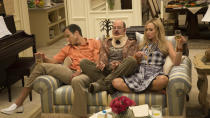Review: “Arrested Development”

There are two questions regarding “Arrested Development,” which returned this weekend via Netflix: Is it good — or as good as it was — and does that really matter? Regarding the second, probably not. That’s because Netflix is emulating HBO by playing the attention-getting game, and as with “House of Cards,” reviving this Emmy-winning comedy has brought the service ample media coverage, reinforcing the perceived value of its original-programming efforts. So a vacillating answer to the first part is virtually irrelevant, especially since Netflix opted not to make episodes available in advance, allowing die-hards and critics (in this case, a group with considerable overlap) to weigh in simultaneously.
Unlike “House of Cards” — a fine if hardly groundbreaking serialized drama — the prospect of binge viewing (Netflix’s main distribution innovation) this new 15-episode batch of “Arrested Development” feels less like a treat than a rather numbing burden. The program’s arched eyebrows, rapid-fire gags and snark actually play better when spread out, and trying to power through multiple episodes felt exactly like that — a bit like cramming for a test the night before.
That’s not to say the cast and series creator Mitchell Hurwitz (who directed with Troy Miller) don’t deliver their share of moments, although the format has a way of blunting them. Each episode essentially focuses on one of the characters, but they frequently intersect — an ambitious narrative approach, if one also seemingly designed to narrow the program’s appeal even further. Inasmuch as the show was canceled for precisely that niche quality despite all its accolades, it’s perhaps advantageous Netflix has resisted releasing user data, allowing the media to create its own echo chamber amplifying the show’s impact, irrespective of the reality.
Ultimately, this “Arrested” revival plays a bit like a reunion special, where the individual cast members come out and take their curtain calls. After the warmth of seeing them reunited (or semi-reunited, given how rarely more than one or two are featured in a scene together), there’s a sort of awkwardness to it, as if nobody really has much to say. We’re meant to bask in the nostalgia, while the particulars are of relatively little consequence.
Beyond Jason Bateman — who has established a busy film resume since the show — the producers have also stocked these episodes with plenty of celebrity cameos, which are alternatively amusing and distracting. Chalk that up, perhaps, to the “Arrested Development” movie that was discussed before the producers settled on this long-delayed “fourth season,” which, given the cultish limits, probably made more sense.
All told, it’s hard to fault anyone involved for making this happen — from Netflix for cashing in on the name to Hurwitz for revisiting the best gig he’s likely to ever have to the cast, who have almost uniformly stayed busy since the show ended but clearly appear to relish re-inhabiting these roles.
Still, wading through the episodes themselves, it’s hard to enthusiastically applaud them for it either. From that perspective, “Arrested Development’s” long-awaited encore is like a lot of TV development — namely, an interesting idea that was more exciting on paper.
Related stories
'Arrested Development' Won't Be Last Show Saved by Digital Content Providers
Upfront Ad Market Starts to Move with Fox in Early Deals
Netflix's Hastings Would Be Willing to Buy More 'Arrested Development' Seasons
Get more from Variety.com: Follow us on Twitter, Facebook, Newsletter
